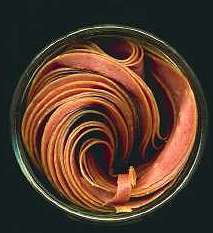
Back تجفيف (طريقة حفظ الأطعمة) Arabic কিউরিং (খাদ্য সংরক্ষণ) Bengali/Bangla Curació Catalan Nasolování Czech Pökeln German Salpeklado Esperanto Curado Spanish Ontze Basque عملآوری (خوراک) Persian Penamaran ID

Curing is any of various food preservation and flavoring processes of foods such as meat, fish and vegetables, by the addition of salt, with the aim of drawing moisture out of the food by the process of osmosis. Because curing increases the solute concentration in the food and hence decreases its water potential, the food becomes inhospitable for the microbe growth that causes food spoilage. Curing can be traced back to antiquity, and was the primary method of preserving meat and fish until the late 19th century. Dehydration was the earliest form of food curing.[1] Many curing processes also involve smoking, spicing, cooking, or the addition of combinations of sugar, nitrate, and nitrite.[1]

Meat preservation in general (of meat from livestock, game, and poultry) comprises the set of all treatment processes for preserving the properties, taste, texture, and color of raw, partially cooked, or cooked meats while keeping them edible and safe to consume. Curing has been the dominant method of meat preservation for thousands of years, although modern developments like refrigeration and synthetic preservatives have begun to complement and supplant it.
While meat-preservation processes like curing were mainly developed in order to prevent disease and to increase food security, the advent of modern preservation methods mean that in most developed countries today[update], curing is instead mainly practiced for its cultural value and desirable impact on the texture and taste of food. For less-developed countries, curing remains a key process in the production, transport and availability of meat.

Some traditional cured meat (such as authentic Parma ham[2] and some authentic Spanish chorizo and Italian salami) is cured with salt alone.[3] Today, potassium nitrate (KNO3) and sodium nitrite (NaNO2) (in conjunction with salt) are the most common agents in curing meat, because they bond to the myoglobin and act as a substitute for oxygen,[4] thus turning myoglobin red.[4][5] More recent evidence shows that these chemicals also inhibit the growth of the bacteria that cause the disease botulism.[4]
The combination of table salt with nitrates or nitrites, called curing salt, is often dyed pink to distinguish it from table salt.[6] Neither table salt nor any of the nitrites or nitrates commonly used in curing (e.g., sodium nitrate [NaNO3],[7] sodium nitrite,[7] and potassium nitrate[8]) is naturally pink.
- ^ a b Nummer, Brian A. (May 2002). "Historical Origins of Food Preservation". National Center for Home Food Preservation. Archived from the original on 15 October 2011. Retrieved 2 January 2023.
- ^ "Parma and Iberian hams, red from zinc". Curious Cook. Retrieved 8 February 2019.
- ^ Coudray, Guillaume (2017). Cochonneries : comment la charcuterie est devenue un poison. Paris. ISBN 9782707193582. OCLC 1011036745.
{{cite book}}: CS1 maint: location missing publisher (link) - ^ a b c Ulin, Don (10 May 2011). "Why Meat Stays Red: Myoglobin And Nitrites". A Moment of Science - Indiana Public Media.
- ^ Schweihofer, Jeannine (21 October 2014). "Cured meat color: Part 3". MSU Extension.
- ^ Bitterman, M. (2010). "Salt Reference Guide". Salted: A Manifesto on the World's Most Essential Mineral, with Recipes. Random House. p. 187. ISBN 978-1580082624. Retrieved 16 August 2013.
- ^ a b Gisslen, W. (2006). "Sausages and Cured Foods". Professional Cooking, College Version. Hoboken, NJ: John Wiley & Sons. p. 827. ISBN 9780471663744. Retrieved 16 August 2013.
- ^ Buege, Dennis (2001). "Information on sausages and sausage manufacture". Meat Science. University of Wisconsin. Archived from the original on 23 December 2003. Retrieved 2 January 2023.